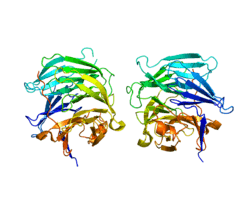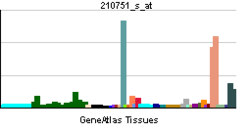Regucalcin
| View/Edit Human | View/Edit Mouse |
Regucalcin is a protein that in humans is encoded by the RGN gene.[3][4]
The protein encoded by this gene is a highly conserved, calcium-binding protein, that is preferentially expressed in the liver and kidney. It may have an important role in calcium homeostasis. Studies in rats indicate that this protein may also play a role in aging, as it shows age-associated down-regulation. This gene is part of a gene cluster on chromosome Xp11.3-Xp11.23. Alternative splicing results in two transcript variants having different 5' UTRs, but encoding the same protein.[4]
Regucalcin is a proposed name for a calcium-binding protein that was discovered in 1978.[5][6][7] This protein is also known as Senescence Marker Protein-30 (SMP30).[8][9] Regucalcin differs from calmodulin and other Ca2+-related proteins as it does not contain an EF-hand motif of Ca2+-binding domain.[5][6] It may regulate the effect of Ca2+ on liver cell functions.[7] From many investigations, regucalcin has been shown to play a multifunctional role in many cell types as a regulatory protein in the intracellular signaling system.
Gene
Regucalcin and its gene (rgn) are identified in 16 species consisting of regucalcin family.[10][11] Regucalcin is greatly expressed in the liver of rats, although the protein is found in small amounts in other tissues and cells. The rat regucalcin gene consists of seven exons and six introns, and several consensus regulatory elements exist upstream of the 5’-flanking region.[12] The gene is localized on the proximal end of rat chromosome Xq11.1-12 and human Xp11.3-Xp11.23. AP-1, NFI-A1, RGPR-p117, and Wnt/β-catenin/TCF4 can bind to the promoter region of the rat regucalcin gene to mediate the Ca2+ and other siganaling responses with various hormones and cytokines for transcriptional activation.[13]
Function
Regucalcin plays a pivotal role in the keep of intracellular Ca2+ homeostasis due to activating Ca2+ pump enzymes in the plasma membrane (basolateral membrane), microsomes (endoplasmic reticulum) and mitochondria of many cells. Regucalcin is localized in the cytoplasm, mitochondria, microsomes and nucleus. Regucalcin is translocated from cytoplasm to nucleus with hormone stimulation. Regucalcin has a suppressive effect on calcium signaling from the cytoplasm to the nucleus in the proliferative cells. Also, regucalcin has been demonstrated to transport into the nucleus of cells, and it can inhibit nuclear protein kinase, protein phosphatase, and deoxyribonucleic acid and ribonucleic acid synthesis. Regucalcin can control enhancement of cell proliferation due to hormonal stimulation. Moreover, regucalcin has been shown to have an inhibitory effect on aminoacyl t-RNA synthetase, a rate limiting enzyme at translational process of protein synthesis and an activatory effect on cystein protease and superoxide dismutase in liver and kidney cells.
Regucalcin is expressed in the neuron of brain tissues, and the decrease of brain regucalcin causes accumulation of calcium in the brain microsomes. Regucalcin has an inhibitory effect on protein kinase and protein phospatase activity dependent on Ca signaling. Regucalcin has been shown to have an activatory effect on Ca pumping enzyme (Ca-ATPase) in heart sarcoplasmic reticulum. Regucalcin plays a role in the promotion of urinary calcium transport in the epithelial cells of kidney cortex. Overexpression of regucalcin suppresses cell death and apoptosis in the cloned rat hepatoma cells and normal rat kidney epithelial cells (NRK52E) induced by various signaling factors.
Thus, regucalcin plays a multifunctional role in the regulation of cell functions in liver, kidney cortex, heart and brain. Thus, regucalcin plays a pivotal role in keep of cell homeostasis and function.[14] Regucalcin plays a pivotal role as a suppressor protein for cell signaling systems in many cell types.
Pathophysiologic role
Overexpressing of regucalcin in rats (transgenic rats) has been shown to induce bone loss and hyperlipidemia with increasing age, indicating a pathophysiologic role. Regucalcin transgenic rat may be a useful tool as animal model in osteoporosis and hyperlipidemia.[15] Also, regucalcin/SMP30-knockout mice are known to induce a suppression in ascorbic acid biosynthesis. The disorder of regucalcin expression has been proposed to be induced cancer, brain function, heart injury, kidney failure, osteoporosis, and hyperlipidemia.
References
- ↑ "Human PubMed Reference:".
- ↑ "Mouse PubMed Reference:".
- ↑ Fujita T, Mandel JL, Shirasawa T, Hino O, Shirai T, Maruyama N (1995). "Isolation of cDNA clone encoding human homologue of senescence marker protein-30 (SMP30) and its location on the X chromosome". Biochim. Biophys. Acta. 1263 (3): 249–52. doi:10.1016/0167-4781(95)00120-6. PMID 7548213.
- 1 2 "Entrez Gene: RGN regucalcin (senescence marker protein-30)".
- 1 2 Yamaguchi M, Yamamoto T (1978). "Purification of calcium binding substance from soluble fraction of normal rat liver". Chem. Pharm. Bull. 26 (6): 1915–8. doi:10.1248/cpb.26.1915. PMID 699201.
- 1 2 Yamaguchi M (1988). "Physicochemical properties of calcium-binding protein isolated from rat liver cytosol: Ca2+-induced conformational changes". Chem. Pharm. Bull. 36 (1): 286–90. doi:10.1248/cpb.36.286. PMID 3378291.
- 1 2 Yamaguchi M (1992). "A novel Ca2+-binding protein regucalcin and calcium inhibition. Regulatory role in liver cell function". Calcium Inhibition. Boca Raton: CRC Press. pp. 19–41.
- ↑ Fujita T, Uchida K, Maruyama N (1992). "Purification of senescence marker protein-30 (SMP30) and its androgen-independent decrease with age in the rat liver". Biochim. Biophys. Acta. 1116 (2): 122–8. doi:10.1016/0304-4165(92)90108-7. PMID 1581340.
- ↑ Fujita T, Shirasawa T, Uchida K, Maruyama N (1992). "Isolation of cDNA clone encoding rat senescence marker protein-30 (SMP30) and its tissue distribution". Biochim. Biophys. Acta. 1132 (3): 297–305. doi:10.1016/0167-4781(92)90164-u. PMID 1420310.
- ↑ Shimokawa N, Yamaguchi M (1993). "Molecular cloning and sequencing of the cDNA coding for a calcium-binding protein regucalcin from rat liver". FEBS Lett. 327 (3): 251–5. doi:10.1016/0014-5793(93)80998-a. PMID 8348951.
- ↑ Misawa H, Yamaguchi M (2000). "The gene of Ca2+-binding protein regucalcin is highly conserved in vertebrate species". Int. J. Mol. Med. 6 (2): 191–6. doi:10.3892/ijmm.6.2.191. PMID 10891565.
- ↑ Yamaguchi M, Makino R, Shimokawa N (1996). "The 5' end sequences and exon organization in rat regucalcin gene". Mol. Cell. Biochem. 165 (2): 145–50. doi:10.1007/bf00229476. PMID 8979263.
- ↑ Yamaguchi M (2011). "The transcriptional regulation of regucalcin gene expression". Mol. Cell. Biochem. 346 (1-2): 147–71. doi:10.1007/s11010-010-0601-8. PMID 20936536.
- ↑ Yamaguchi M (2005). "Role of regucalcin in maintaining cell homeostasis and function (review)". Int. J. Mol. Med. 15 (3): 371–89. doi:10.3892/ijmm.15.3.371. PMID 15702226.
- ↑ Yamaguchi M (2010). "Regucalcin and metabolic disorders: osteoporosis and hyperlipidemia are induced in regucalcin transgenic rats". Mol. Cell. Biochem. 341 (1-2): 119–33. doi:10.1007/s11010-010-0443-4. PMID 20349117.
Further reading
- Fujita T, Shirasawa T, Maruyama N (1999). "Expression and structure of senescence marker protein-30 (SMP30) and its biological significance". Mech. Ageing Dev. 107 (3): 271–80. doi:10.1016/S0047-6374(98)00136-5. PMID 10360682.
- Maruyama K, Sugano S (1994). "Oligo-capping: a simple method to replace the cap structure of eukaryotic mRNAs with oligoribonucleotides". Gene. 138 (1-2): 171–4. doi:10.1016/0378-1119(94)90802-8. PMID 8125298.
- Suzuki Y, Yoshitomo-Nakagawa K, Maruyama K, Suyama A, Sugano S (1997). "Construction and characterization of a full length-enriched and a 5'-end-enriched cDNA library". Gene. 200 (1-2): 149–56. doi:10.1016/S0378-1119(97)00411-3. PMID 9373149.
- Misawa H, Yamaguchi M (2000). "Transcript heterogeneity of the human gene for Ca2+-binding protein regucalcin". Int. J. Mol. Med. 5 (3): 283–7. doi:10.3892/ijmm.5.3.283. PMID 10677570.
- Thiselton DL, McDowall J, Brandau O, Ramser J, d'Esposito F, Bhattacharya SS, Ross MT, Hardcastle AJ, Meindl A (2002). "An integrated, functionally annotated gene map of the DXS8026-ELK1 interval on human Xp11.3-Xp11.23: potential hotspot for neurogenetic disorders". Genomics. 79 (4): 560–72. doi:10.1006/geno.2002.6733. PMID 11944989.
- Ishigami A, Handa S, Maruyama N, Supakar PC (2003). "Nuclear localization of senescence marker protein-30, SMP30, in cultured mouse hepatocytes and its similarity to RNA polymerase". Biosci. Biotechnol. Biochem. 67 (1): 158–60. doi:10.1271/bbb.67.158. PMID 12619687.
- Matsuyama S, Kitamura T, Enomoto N, Fujita T, Ishigami A, Handa S, Maruyama N, Zheng D, Ikejima K, Takei Y, Sato N (2004). "Senescence marker protein-30 regulates Akt activity and contributes to cell survival in Hep G2 cells". Biochem. Biophys. Res. Commun. 321 (2): 386–90. doi:10.1016/j.bbrc.2004.06.161. PMID 15358188.
- Warizaya M, Kinoshita T, Yamaoka M, Shibata T, Saito N, Nakajima H, Fujii T (2004). "Expression, purification, crystallization and preliminary X-ray diffraction studies of human liver regucalcin". Acta Crystallogr. D. 60 (Pt 11): 2019–21. doi:10.1107/S0907444904020608. PMID 15502314.
- Ishigami A, Fujita T, Inoue H, Handa S, Kubo S, Kondo Y, Maruyama N (2005). "Senescence marker protein-30 (SMP30) induces formation of microvilli and bile canaliculi in Hep G2 cells". Cell Tissue Res. 320 (2): 243–9. doi:10.1007/s00441-004-1073-5. PMID 15714273.
- Yamaguchi M, Daimon Y (2005). "Overexpression of regucalcin suppresses cell proliferation in cloned rat hepatoma H4-II-E cells: involvement of intracellular signaling factors and cell cycle-related genes". J. Cell. Biochem. 95 (6): 1169–77. doi:10.1002/jcb.20490. PMID 15962315.

